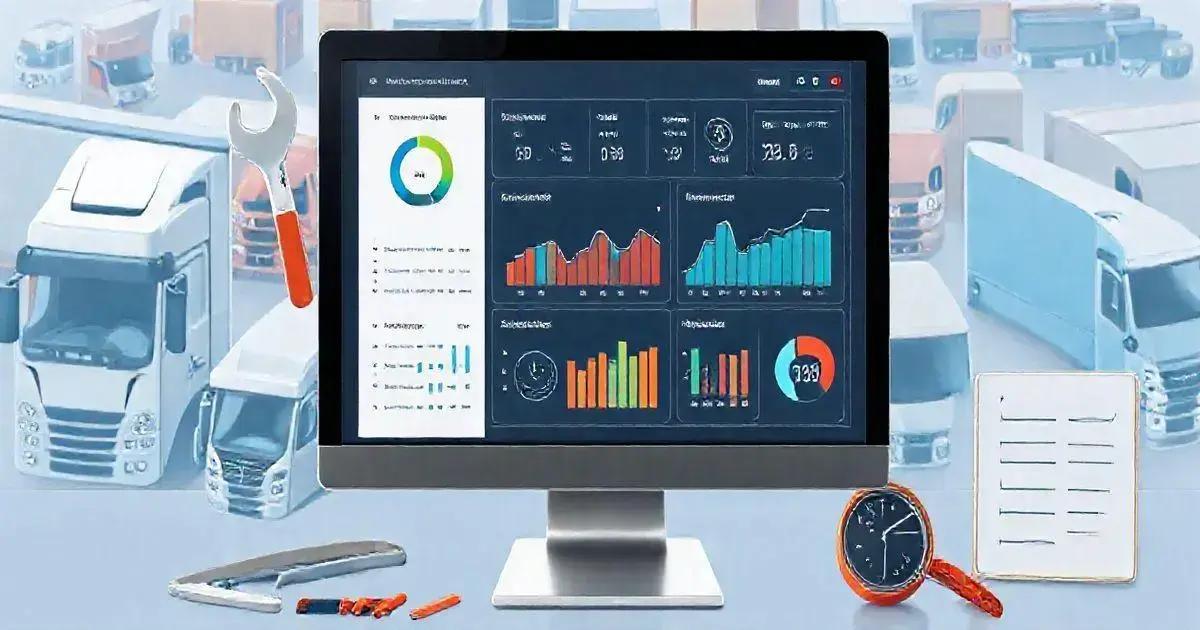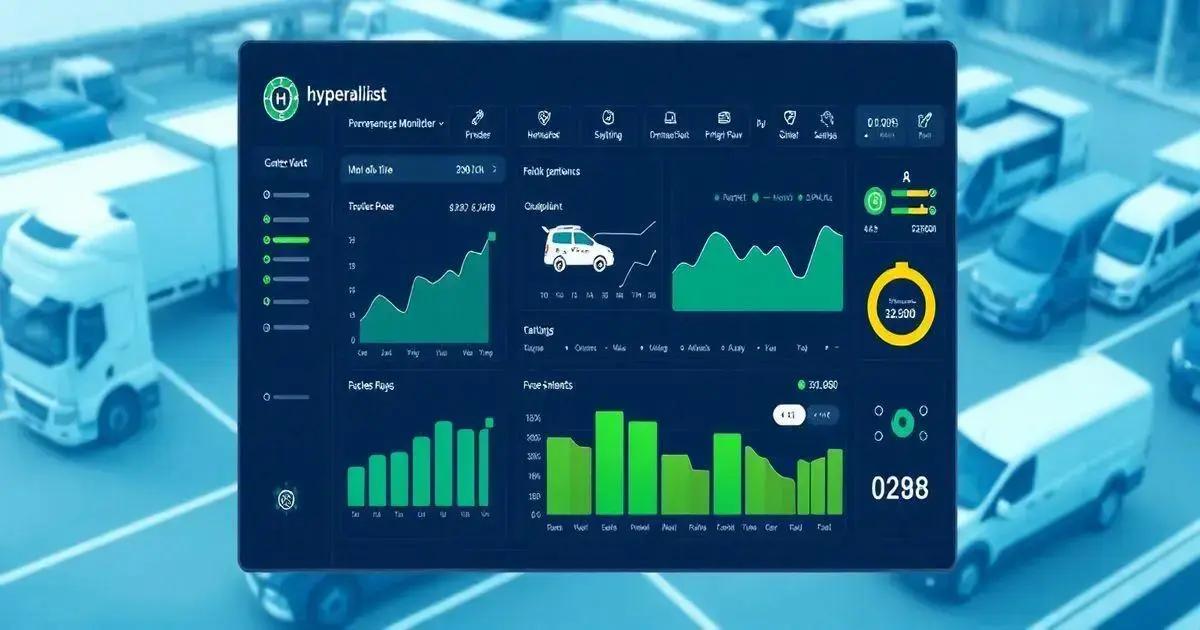Fleet Control Worksheet 7.0: Maximize Your Fleet Management Leave a comment
The Fleet Control Worksheet 7.0 is a vital tool for fleet management, offering features like an intuitive dashboard for tracking kilometers driven, fuel consumption, and maintenance costs, along with document management for drivers and vehicles. It enhances travel control by linking cargo to trips and managing expenses, while proactive maintenance scheduling promotes vehicle longevity. The FAQ section addresses installation and support, making it essential for improving operational efficiency and profitability in fleet management.
Are you looking to streamline your fleet management process? The Fleet Control Worksheet 7.0 is designed just for that! With features that allow you to monitor vehicle travel, maintenance schedules, and fuel consumption, this worksheet can help you keep your fleet running smoothly.
In this guide, we will delve into the various aspects of the Fleet Control Worksheet 7.0, showing you how to optimize your fleet operations.
Initial Dashboard Features
The Fleet Control Worksheet 7.0 comes equipped with a comprehensive dashboard that provides essential insights at a glance. Here are the key features:
- KM by Driver: Track the total kilometers driven by each driver, allowing for performance assessments and accountability.
- KM per Vehicle: Monitor the distance traveled by individual vehicles, providing valuable information for maintenance schedules and vehicle usage analysis.
- KM per Liter: Calculate fuel efficiency by determining kilometers driven per liter of fuel consumed, enabling better fuel management.
- KM per Trip: Analyze the distance covered for each trip to identify patterns and optimize routes for cost efficiency.
- Average Consumption per Vehicle: Evaluate the average fuel consumption of each vehicle to make informed decisions regarding fuel usage and vehicle maintenance.
- Average Consumption per Driver: Assess each driver’s fuel consumption to encourage efficient driving practices and reduce expenses.
- Total General Maintenance: Overview of all maintenance tasks completed—both preventive and corrective—ensuring your fleet stays in top shape.
- Maintenance Cost Average: Calculate the average costs associated with maintenance over time for better budgeting and financial planning.
- Total Cost of Mechanical and Electrical Maintenance: Keep track of comprehensive maintenance costs to help with forecasting and resource allocation.
- Total Tire Maintenance Cost: Monitor expenses related to tire maintenance, which can impact overall fleet operation costs.
- Total Lubricant Cost: Track lubricants used across the fleet to optimize inventory and spending.
- Average Costs by Maintenance Type: Evaluate average costs associated with different types of maintenance, enabling strategic financial decisions.
- Vehicles in Transit: Keep a real-time tally of vehicles on the road to ensure efficient operation and scheduling.
- Tires in Transit: Monitor tire status during trips to preemptively address any issues that may arise.
- Delayed Vehicle Documents: Highlight vehicles with pending documentation to maintain compliance and avoid penalties.
- Delayed Driver Documents: Keep track of driver documentation status to ensure all personnel are compliant and ready for duty.
- Delayed Preventive Maintenance: Identify overdue maintenance tasks to avoid costly repairs and maximize vehicle availability.
- Total Cost Versus Shipping: Analyze total costs against shipping outputs to assess profitability and efficiency in the fleet’s operations.
- Fuel, Maintenance, and Other Costs: Consolidate all costs associated with fleet operations for a comprehensive financial overview.
Utilizing these dashboard features, fleet managers can make data-driven decisions, enhance vehicle performance, and effectively control operational costs, ultimately leading to improved efficiency and profitability.

Registration and Document Management
The Fleet Control Worksheet 7.0 emphasizes the importance of maintaining an organized and accessible system for vehicle and driver registrations and document management. Here are the critical components:
- Driver Registration: This section allows for comprehensive records of all drivers, including personal details, contact information, and driving history. Keeping this data updated is essential for compliance and effective management.
- Vehicle Type Registration: Capturing information about each vehicle in the fleet, such as make, model, year, and specifications, ensures that fleet managers have a clear understanding of their assets.
- Mechanical and Electrical Services Registry: Documenting all mechanical and electrical services performed on each vehicle enables proactive maintenance management and helps in tracking service history.
- Tree Service Registration: This section aids in registering details of servicing trees or other related services provided by the fleet, ensuring comprehensive documentation of all operational activities.
- Lubricant Services Register: Keeping track of lubricant services used in the fleet is vital for ensuring optimal vehicle performance and identifying recurring expenses.
- Register of Workshops and Suppliers: Maintaining a list of trusted workshops and suppliers creates a reliable resource for vehicle repairs and parts acquisition, ensuring consistent quality and service availability.
- Expenditure Type Register: This helps in categorizing different types of expenditures related to fleet management, enabling better budgeting and financial planning.
- Refueling Station Registration: Register refueling stations used by the fleet to streamline fueling processes and track fuel expenses effectively.
- Fuel Type Register: Documenting the types of fuel used across the fleet assists in managing fuel costs and compliance with environmental regulations.
By implementing an efficient registration and document management system, fleet managers can ensure compliance with legal requirements, improve operational efficiency, and maintain a clear overview of their fleet’s performance.
Travel Control and Expenses
Effective management of travel control and expenses is crucial for maintaining the operational efficiency of your fleet. The Fleet Control Worksheet 7.0 provides versatile tools to track and analyze travel-related data, ensuring that all expenses are accounted for and optimized. Here’s what you can expect:
Travel Control and Expenses
- Cargo Control Linked to Trips: This feature allows fleet managers to associate specific cargo loads with their respective trips, making it easier to track deliveries and ensure accountability.
- Vehicle Control: Monitor the assignment of vehicles to specific trips, granting insights into usage patterns, availability, and maintenance scheduling.
- Driver Control: Keep track of which drivers are assigned to specific trips, facilitating better management of driver schedules and ensuring compliance with work hour regulations.
- Supply Control: Manage supplies necessary for each trip, including fuel, food, and other essentials, which helps in budgeting and avoiding unnecessary costs.
- Control of All Travel Expenses: This section consolidates all travel-related expenses, including fuel, tolls, accommodation, and meals, to provide a comprehensive overview of costs associated with each trip.
By utilizing these features, fleet managers can enhance transparency and accountability in travel operations, ultimately leading to more informed financial decisions and operational improvements. Keeping travel expenses in check not only boosts efficiency but also contributes to overall cost-saving strategies for the fleet.

Maintenance Control Strategies
Maintenance is a pivotal aspect of fleet management that ensures vehicles remain in excellent condition, minimizing downtime and repair costs. The Fleet Control Worksheet 7.0 offers robust strategies for managing maintenance effectively. Here’s how:
Maintenance Control Strategies
- Corrective and Preventive Maintenance Type: Differentiate between corrective maintenance (repairs after a failure) and preventive maintenance (scheduled servicing to prevent failures). This distinction allows fleet managers to allocate resources effectively and plan maintenance activities.
- Maintenance by Vehicle: Track maintenance activities specific to each vehicle in the fleet. This feature helps identify vehicles that may require more frequent servicing, allowing managers to address issues proactively.
- Maintenance by Mechanical and Electrical Type: Organize maintenance records based on mechanical and electrical issues. Understanding the types of maintenance required can help in pinpointing trends and potential systemic problems within the fleet.
- Maintenance Cost Tracking: Keep a detailed record of maintenance costs incurred for each vehicle. This data is essential for budgeting, forecasting, and identifying which vehicles are more costly to maintain.
- Preventive Maintenance Schedule: Establish a proactive maintenance schedule that outlines when routine tasks should be performed. Regular check-ups can help catch issues before they escalate, ensuring the longevity of the fleet.
- Preventive Maintenance Signal: Utilize alerts or signals within the worksheet to remind fleet managers of upcoming preventive maintenance tasks, ensuring timely completion of necessary services.
- Status by Scheduled, Accomplished, and Delayed: Monitor the status of maintenance tasks to maintain visibility on what’s scheduled, what has been completed, and what is overdue. This oversight helps prioritize maintenance efforts and ensures compliance with safety standards.
Implementing these maintenance control strategies through the Fleet Control Worksheet 7.0 not only extends the lifespan of vehicles but also improves overall fleet safety and reliability. By investing in effective maintenance management, fleet operators can reduce costs and enhance operational efficiency.
Frequently Asked Questions
Here are some common questions regarding the Fleet Control Worksheet 7.0, along with their answers to help you maximize its benefits:
Frequently Asked Questions
- Can I install the Fleet Control Worksheet on multiple computers?
Yes, you can install the worksheet on as many computers as you need, allowing for flexible access across your team. - Is there a monthly fee for using the Fleet Control Worksheet?
No, the purchase of the worksheet is a one-time payment, and there are no ongoing monthly fees. - Does the worksheet work with any version of Excel?
Absolutely! The Fleet Control Worksheet is compatible with all versions of Excel, including 2003, 2007, 2010, 2013, and 2016. - What kind of technical support is provided if I encounter issues?
Technical assistance is available free of charge from Monday to Friday, from 9 AM to 4 PM. Support can be provided via email or WhatsApp. - Can I request modifications to the worksheet?
No, requests for changes that modify the structure of the worksheet are not included in the assistance package. If modifications are needed, a quotation must be requested from the development department. - Is the worksheet sold unlocked?
Yes, the Fleet Control Worksheet is completely unlocked, allowing you to customize it as needed. - If I format my computer, do I need to buy the program again?
No, you can save the program to a USB flash drive or re-download it from your email without incurring additional costs.
If you have any other questions or need further assistance, feel free to reach out to our support team. We’re here to help you get the most out of your Fleet Control Worksheet!
Conclusion
The Fleet Control Worksheet 7.0 is an invaluable tool for fleet managers, designed to streamline operations, enhance vehicle monitoring, and optimize maintenance management.
By leveraging the features of this worksheet, you can efficiently manage driver registrations, track travel expenses, and keep meticulous records of maintenance activities.
Implementing effective maintenance control strategies will ensure your fleet remains in top condition, reducing downtime and operational costs.
Furthermore, the comprehensive dashboard allows for quick insights into performance metrics, empowering you to make informed decisions.
In essence, the Fleet Control Worksheet 7.0 not only aids in day-to-day management but also contributes to long-term fleet sustainability and profitability.
Embrace the power of organized fleet management today to drive your operations forward.
FAQ – Frequently Asked Questions about Fleet Control Worksheet 7.0
Can I install the Fleet Control Worksheet on multiple computers?
Yes, you can install the worksheet on as many computers as you need, allowing for flexible access across your team.
Is there a monthly fee for using the Fleet Control Worksheet?
No, the purchase of the worksheet is a one-time payment, and there are no ongoing monthly fees.
Does the worksheet work with any version of Excel?
Absolutely! The Fleet Control Worksheet is compatible with all versions of Excel, including 2003, 2007, 2010, 2013, and 2016.
What kind of technical support is provided if I encounter issues?
Technical assistance is available free of charge from Monday to Friday, from 9 AM to 4 PM. Support can be provided via email or WhatsApp.
Can I request modifications to the worksheet?
No, requests for changes that modify the structure of the worksheet are not included in the assistance package. If modifications are needed, a quotation must be requested from the development department.
Is the worksheet sold unlocked?
Yes, the Fleet Control Worksheet is completely unlocked, allowing you to customize it as needed.
If I format my computer, do I need to buy the program again?
No, you can save the program to a USB flash drive or re-download it from your email without incurring additional costs.

